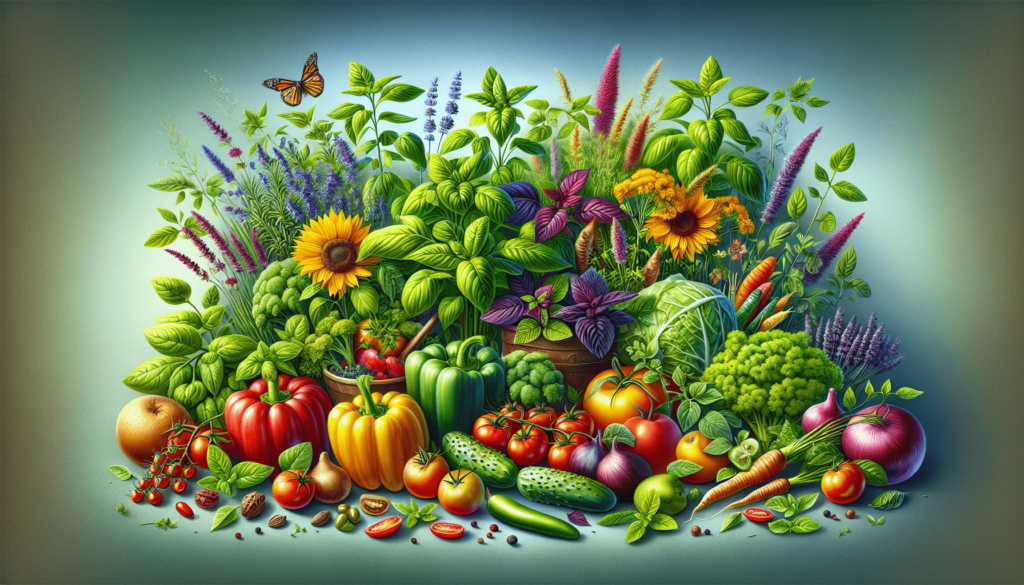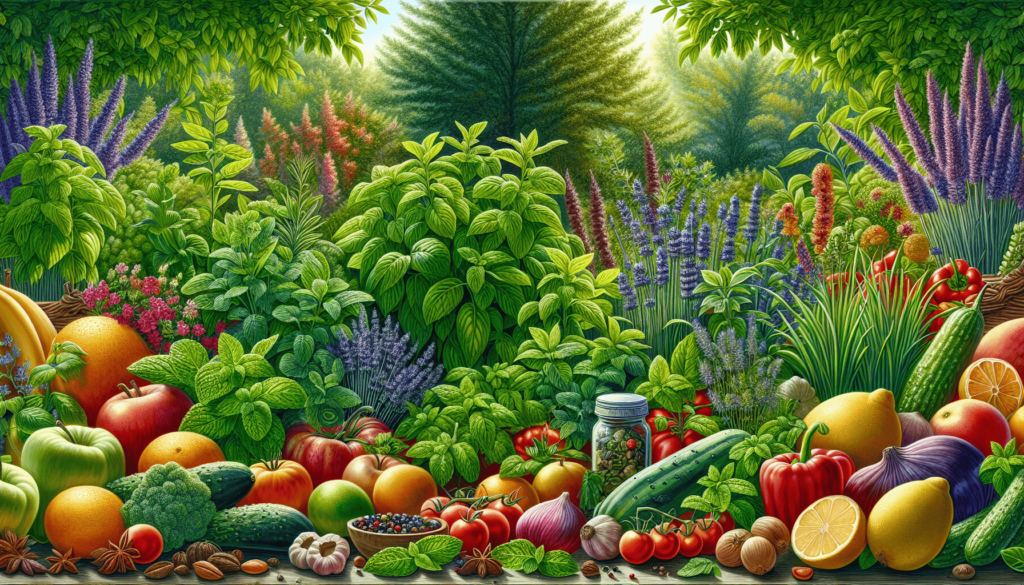Have you ever considered creating a garden for wellness and health? Gardening is not only a great way to relax and de-stress, but it can also provide you with fresh, nutritious produce and a beautiful outdoor space to enjoy. In this ultimate guide, we will walk you through the steps of creating a garden that promotes wellness and enhances your overall health. Let’s get started!

Planning Your Garden Space
Before you start digging and planting, it’s important to plan out your garden space. Consider the amount of sunlight your garden will receive, the size of your space, and what types of plants you want to grow. By carefully planning your garden, you can ensure that it will thrive and provide you with the maximum benefits for your health and wellness.
Assessing Sunlight
Make sure to choose a sunny spot for your garden, as most vegetables and herbs require at least 6-8 hours of sunlight per day. If your space is limited, consider container gardening on a balcony or patio to maximize sunlight exposure.
Determining Garden Size
Take into account the amount of space you have available for gardening. If you have a small yard, you can still create a thriving garden by utilizing raised beds or vertical gardening techniques. Don’t let a small space limit your ability to grow your own fresh produce!
Choosing Plants
Decide what types of plants you want to grow in your garden. Consider planting a mix of vegetables, herbs, and flowers to attract beneficial insects and pollinators. Choose plants that are well-suited to your climate and soil type to ensure they will thrive in your garden.
Creating a Garden Layout
Once you have planned out your garden space, it’s time to create a layout that maximizes the health and wellness benefits of your garden. By designing your garden with mindfulness and intention, you can create a space that is not only beautiful but also promotes relaxation and well-being.
Designing Garden Beds
Consider creating raised garden beds to make gardening easier on your back and knees. Raised beds also provide better drainage and soil quality, resulting in healthier plants. Arrange your garden beds in a way that allows for easy access and maintenance.
Adding Pathways
Incorporate pathways into your garden design to create a sense of flow and connectivity. Pathways can be made from a variety of materials, such as gravel, stepping stones, or wood chips. Connect different areas of your garden with pathways to make it easy to move around and care for your plants.
Creating Seating Areas
Include seating areas in your garden where you can relax and enjoy the beauty of your surroundings. Add a bench, hammock, or outdoor furniture to create a comfortable space for reading, meditating, or simply soaking up the sunshine. Design your seating areas to take advantage of the best views and natural elements in your garden.
Choosing Plants for Health and Wellness
When selecting plants for your garden, consider not only their beauty but also their health and wellness benefits. Certain plants have medicinal properties, can purify the air, or attract beneficial insects that support a healthy ecosystem. By choosing plants with specific health benefits, you can create a garden that promotes your overall well-being.
Medicinal Herbs
Plant medicinal herbs such as lavender, echinacea, and chamomile in your garden to create a natural pharmacy at your fingertips. These herbs have been used for centuries to treat common ailments and promote healing. Use fresh herbs in teas, tinctures, or homemade remedies to support your health and well-being.
Air-Purifying Plants
Incorporate air-purifying plants like snake plants, peace lilies, and spider plants into your garden to improve indoor air quality and reduce toxins. These plants can help remove harmful pollutants from the air, creating a healthier environment for you and your family. Place air-purifying plants in your home or office to enjoy their benefits year-round.
Pollinator Plants
Plant flowers such as bee balm, sunflowers, and butterfly bush to attract pollinators like bees, butterflies, and hummingbirds to your garden. Pollinators play a crucial role in the ecosystem by helping plants reproduce and produce fruits and seeds. By supporting pollinators in your garden, you can help maintain biodiversity and create a thriving ecosystem.
Maintaining a Healthy Garden
Once your garden is planted and thriving, it’s important to maintain it with care and attention to ensure continued health and wellness benefits. By following best practices for gardening and taking a mindful approach to maintenance, you can enjoy a beautiful and bountiful garden year-round.
Watering Properly
Water your garden regularly and deeply to keep plants healthy and hydrated. Most plants require about 1 inch of water per week, depending on the weather and soil conditions. Use a soaker hose or drip irrigation system to water efficiently and reduce water waste. Check soil moisture levels regularly to avoid overwatering or underwatering your plants.
Mulching
Apply a layer of mulch around your plants to help retain moisture, suppress weeds, and improve soil health. Mulch can be made from a variety of materials, such as straw, wood chips, or compost. Choose a mulch that is appropriate for your garden and apply it evenly to create a protective barrier for your plants.
Fertilizing Naturally
Feed your plants with natural fertilizers like compost, manure, or organic plant food to provide essential nutrients for growth and blooming. Avoid synthetic fertilizers that can harm the environment and disrupt the natural balance of your garden. Fertilize your plants regularly during the growing season to support healthy growth and abundant yields.

Harvesting and Preserving Your Garden Bounty
As your garden begins to flourish, you will be rewarded with a bounty of fresh produce, herbs, and flowers to enjoy. Harvest your garden regularly to promote continued growth and to enjoy the fruits of your labor. By preserving your garden bounty through freezing, drying, or canning, you can enjoy the health and wellness benefits of your garden year-round.
Harvesting Produce
Pick fruits and vegetables when they are ripe and ready to eat to maximize freshness and flavor. Harvest leafy greens, root vegetables, and herbs as needed for salads, soups, and cooking. Use gentle harvesting techniques to avoid damaging plants and encourage new growth for future harvests.
Preserving Herbs
Dry or freeze herbs like basil, mint, and parsley to preserve their flavor and aroma for later use. Hang herbs to dry in a warm, well-ventilated area or freeze them in ice cube trays with water or oil. Store dried herbs in airtight containers away from heat and light to maintain their potency and freshness.
Canning Fruits and Vegetables
Can surplus fruits and vegetables like tomatoes, cucumbers, and berries to enjoy them throughout the year. Use a water bath canner or pressure canner to safely preserve your harvest and prevent spoilage. Follow canning guidelines and recipes to ensure that your canned goods are safe and delicious.
Creating a Relaxation and Meditation Garden
For the ultimate in wellness and health benefits, consider creating a relaxation and meditation garden in your outdoor space. By incorporating elements of nature, tranquility, and mindfulness, you can create a sanctuary for relaxation and rejuvenation. Design your garden with serenity and peace in mind to promote mental and emotional well-being.
Zen Garden
Design a Zen garden with minimalist features like rocks, gravel, and bonsai trees to create a sense of calm and tranquility. Arrange stones in patterns, rake gravel in soothing designs, and plant moss and ferns for a serene atmosphere. Add a water feature like a small pond or fountain to enhance the meditative quality of your garden.
Meditation Space
Create a dedicated meditation space in your garden with a comfortable cushion, meditation altar, and meaningful objects. Design a quiet corner or secluded nook where you can practice mindfulness, yoga, or meditation in nature. Surround your meditation space with fragrant flowers, herbs, and plants to engage your senses and soothe your soul.
Sound and Scent
Incorporate sound and scent elements into your garden to enhance the sensory experience and promote relaxation. Add wind chimes, singing bowls, or bells to create soothing sounds that calm the mind and body. Plant fragrant flowers like lavender, jasmine, and rosemary to fill the air with calming aromas and uplift your spirits.
Conclusion
Creating a garden for wellness and health is a rewarding and fulfilling experience that can enrich your life in countless ways. By planning your garden space, choosing plants for health and wellness, and maintaining your garden with care, you can enjoy the benefits of gardening year-round. Whether you are growing vegetables, herbs, or flowers, your garden can be a source of nourishment, healing, and joy for both your body and soul. Start your gardening journey today and reap the many rewards of a garden that promotes wellness and enhances your overall health.

